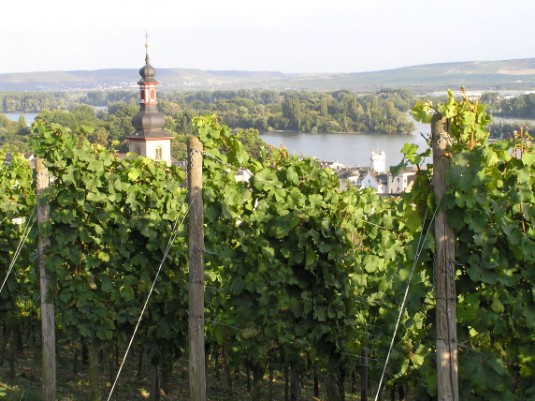
- Johannisberg
- Kiedrich
- Lorch
- Lorchhausen
- Mainz
-
- Martinsthal
- Mittleheim
- Niederwalluf
- Oberwalluf
- Ostrich
- Rauenthal
- Rüdesheim
- Wiesbaden
- Wicker
-
- Winkel
Schloßberg (Erste gewächs vineyard) 53 ha mostly Riesling
Kapellenberg (Erste gewächs vineyard) 58 ha mostly Riesling
Krone (Erste gewächs vineyard) 13 ha mostly Riesling
Pfaffenwies (Erste gewächs vineyard) 35 ha mostly Riesling
Bodental-Steinberg (Erste gewächs vineyard) 23 ha mostly Riesling
Berg Roseneck (Erste gewächs vineyard) 26.7ha Hunsrück Slate
Berg Schloßberg (Erste gewächs vineyard) 25.3 ha
Kirchenpfad 20 ha
Klosterberg 39 ha
Magdalenen-Kreuz (Erste gewächs vineyard) 49 ha
Rosengerten 3.7 ha
Rothenberg (Erste gewächs vineyard) 36 ha
Kläuserweg (Erste gewächs vineyard) 57 ha
Fuchsberg (Erste gewächs vineyard) 68 ha
Kilzberg 56 ha
Mäuerchen (Erste gewächs vineyard) 33 ha
Mönchspfad (Erste gewächs vineyard) 160 ha
Schloßgarten 18 ha
Klaus
Mainz Orsteil Kostheim (village)
Reichesthal
WeißErd (Erste gewächs vineyard)
Steig
Berg
Reichesthal (Erste gewächs vineyard) 26.5 ha
Berg 35 ha
Königin Victoriaberg (Erste gewächs vineyard) 5 ha
Hofmeister (Erste gewächs vineyard) 34 ha
Stielweg (Erste gewächs vineyard) 26 ha
Sommerheil
Hölle (Erste gewächs vineyard) 57 ha
Domdechaney (Erste gewächs vineyard) 10.5 ha
Kirchenstück (Erste gewächs vineyard) 16 ha
Stein (Erste gewächs vineyard) 27 ha
Herrnberg 4 ha
Stein (Erste gewächs vineyard) 20 ha
Mönchsgewann (Erste gewächs vineyard) 18 ha
König Wilhelmsberg 2.1 ha
Nonnenberg 2.4 ha
Herrnberg (Erste gewächs vineyard) 20 ha
Lohrberger Hang 1.7 ha
Lankreis Melsungen Berg
GROSSLAGE: Deutelsberg
Mannberg (Erste gewächs vineyard) 11 ha
Nußbrunnen (Erste gewächs vineyard) 10 ha
Wisselbrunnen (Erste gewächs vineyard) 18 ha
Hasslel (Erste gewächs vineyard) 30 ha
Heiligenberg 36 ha
Schützenhaus (Erste gewächs vineyard) 66 ha
Engelmannsberg (Erste gewächs vineyard) 20 ha
Pfaffenberg (Erste gewächs vineyard) 6 ha
Steinberg 31 ha
Klaus (Erste gewächs vineyard) 15 ha
Schwarzenstein 5.5 ha
Vogelsang 14 ha
Hölle (Erste gewächs vineyard) 27 ha
Hansenberg 4 ha
Goldatzel 24 ha
Mittelhölle 6.5 ha
Schloß Johannisberg 35 ha
GROSSLAGE: Gottesthal
Ostrich
Klosterg 142 ha
Lenchen (Erste gewächs vineyard) 145 ha
Doosberg (Erste gewächs vineyard) 152 ha
Schloß Reichhartshausen 3 ha
GROSSLAGE: Heiligenstock
Klosterberg 67 ha
Gräfenberg (Erste gewächs vineyard) 11 ha
Wasseros (Erste gewächs vineyard) 36 ha
Sandgrub (Erste gewächs vineyard) 58 ha
GROSSLAGE: Honigberg
Klaus
Gutenberg (Erste gewächs vineyard) 51 ha
Schloßberg (Erste gewächs vineyard) 33 ha
Jesuitsgarten (Erste gewächs vineyard) 26 ha
Hasensprung (Erste gewächs vineyard) 100 ha
Biennengarten
Schloß Vollrads (Erste gewächs vineyard) 58 ha
St Nikolaus (Erste gewächs vineyard) 50 ha
Schönhell (Erste gewächs vineyard) 58 ha
Würzgarten 42 ha
Jungfer (Erste gewächs vineyard) 55 ha
Hendelberg 53 ha
Marcobrunn (Erste gewächs vineyard) 5.2 ha
Schloßberg (Erste gewächs vineyard) 6 ha
Siegelsberg (Erste gewächs vineyard) 16 ha
Honigberg 100 ha
Michelmark (Erste gewächs vineyard) 75 ha
Hohenrain (Erste gewächs vineyard) 18 ha
Steinmorgen (Erste gewächs vineyard) 32 ha
Rheinhell 18 ha
GROSSLAGE: Steil
Assmannshausen Aulhausen (village)
Frankenthal (Erste gewächs vineyard) 45 ha mostly Spätburgunder
Höllenberg (Erste gewächs vineyard) 55 ha mostly Spätburgunder
Hinterkirch 59 ha mostly Spätburgunder
Berg Kaiserstein
GROSSLAGE: Steinmacher
Taubenberg (Erste gewächs vineyard) 80 ha
Langenstück (Erste gewächs vineyard) 63 ha
Sonnenberg (Erste gewächs vineyard) 68 ha
Rheinberg (Erste gewächs vineyard) 30 ha
Sandgrub
Kalbspflicht (Erste gewächs vineyard) 10 ha
Baiken (Erste gewächs vineyard) 15 ha
Gehrn (Erste gewächs vineyard) 18 ha
Wülfen (Erste gewächs vineyard) 14 ha
Rothenburg (Erste gewächs vineyard) 20 ha
Langenstück 25.8
Nonnenberg 5.6 ha
Wildsau (Erste gewächs vineyard) 31 ha
Langenberg (Erste gewächs vineyard) 19 ha
Rödchen (Erste gewächs vineyard) 28.1 ha
Berg- Bildstock
Walkenberg
Oberberg
Fitusberg
Langenstück
Neroberg (no Grosslagen) 4.4ha
Wiesbaden orsteil Schierstein (village)
Dachsberg 27.3
Hölle 32.6 ha
Wiesbaden orsteil Frauenstein (village)
Marschall 8.5 ha
Homberg 8.3 ha
Herrnberg 58.6
Wiesbaden orsteil Doltzheim (village)
Judenkirch 10.3 ha
Back to content
